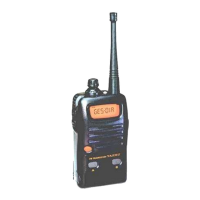~
Receive Signal
Path
Incoming
RF
from
the
antenna
jack is deliv-
ered
to
the
RF
Unit
and
passes
through
a
low-
pass
filter
and
high-pass filter consisting
of
coils
L1006, L1007, L1008, L1010, L1011
& L1012, ca-
pacitors
C1033, C1034, C1046, C1047, C1048,
C1049, C1050, C1064, C1076, C1077, C1081
&
C1082
and
antenna
switching
diode
D1008
(RLS135).
Signals
within
the
frequency
range
of
the
transceiver
are
then
amplified
by
Ql
019
(2SC5226-4/5)
and
enter
a
varactor-tuned
band-
pass
filter
consisting
of
coils L 1015, L 1016 &
,-,
L1017,
capacitors
C1017, C1087, C1089, C1090,
C1091, C1099, C1100,
C1108, C1111,
Cll12,
~.
C1113, C1158, C1162 & C1166,
and
diodes D1012,
D1013
& D1014 (all HVU350) before first mixing
by
Q1026 (SGM2016M).
Buffered
output
from
the
VCO
is
amplified
by
Q1001 (2SC5226-4/5) to
providea
pure
first
local
signal
between
116.3
and
156.3
MHz
for
injection
to
the
first
mixer
Q1026 (SGM2016M).
The
17.7
MHz
first
mixer
product
then
passes
through
monolithic crystal filters XF1001, XF1002
(17T1285, 7.5
kHz
BW)
to
strip
away
all
but
the
desired
signal,
which
is
then
amplified
by
Q1028
(2SC4215Y).
The
amplified
first IF signal is
applied
to FM
IF
subsystemIC
Q1020 (TA31136FN),
which
con-
tains
the
second
mixer,
second
local oscillator,
limiter
amplifier,
noise
amplifier,
and
S-meter
amplifier.
A
second
local signal is
generated
by
PLL ref-
erence
I
second
local
oscillator
Q
1018
(2SC2620QB)
from
the 17.25
MHz
crystal
XlOOl
to
produce
the
450kHz
second
IF
when
mixed
with
the
first IF
signal
within
Q1020.
The
second
IF
then
passes
through
the
ceram-
Circuit
Description
ic filter CF1001
to
strip
away
unwanted
mixer
products,
and
is
applied
to
the
limiter
amplifier
in
Q1020,
which
removes
amplitude
variations
in
the
450kHz
IF, before
detection
of
the
speech
by
the
ceramic
discriminator
CD1001
(CDBM450C24T).
Detected
audio
from
Q1020 is
applied
to
one
of the
user
selected Key Unit for
de-emphasis
and
band-pass
filtering (see the Key Unit
Circuit
De-
scription),
and
then
past
the
volume
control
to
the
audio
power
amplifier
Q2021 (TDA7233D)
on
the
CNTL
Unit,
providing
up
to 0.5
Watts
to
the
optional
headphone
jack
or
4-Q
loudspeak-
er.
Squelch Control
The
squelch
circuitry
consists
of
a
noise
am-
plifier &
band-pass
filter
within
Q1020,
and
noise
detector
D1018 (DA221)
on
the
CNTL
Unit.
When
no
carrier
is received,
noise
at
the
out-
put
of
the
detector
stage
in
Q1020 is
amplified
and
band-pass
filtered
by
the noise amplifier sec-
tion
of Q1020
and
the
network
between
pins
7
and
8,
and
then
rectified
by
Dl018.
The
resulting
DC
squelch
control
voltage
is
passed
to
pin
96
of
the
microprocessor
Q2001.
If
no
carrier
is received, this
signal
causes
pins
43
and
55
of
Q2001
to
go
low.
Pin
43 signals Q2018
(IMD1
OA)
and
Q2020 (UMH3N)
to
disable
the
supply
voltage
to
the
audio
amplifier
Q2021,
while
pin
55
makes
Q2008 (FMG2) hold the
green
(Busy)
half
of
the
LED off,
when
these
pins
are
low.
Thus,
the
microprocessor
blocks
output
from
the
audio
amplifier,
and
silences
the
receiver
while
no
signal
is
being
received,
and
during
transmission.
When
a
carrier
appears
at
the
discriminator,
-
~------~------~------------------------------------------1-17
VX-10 VHF Band Service
Manual

